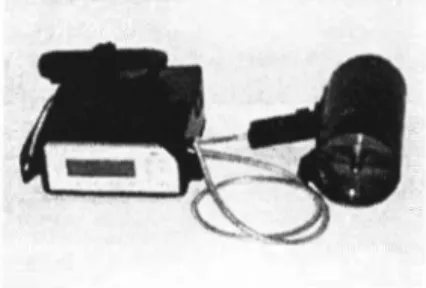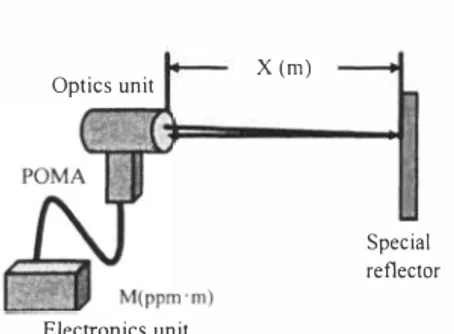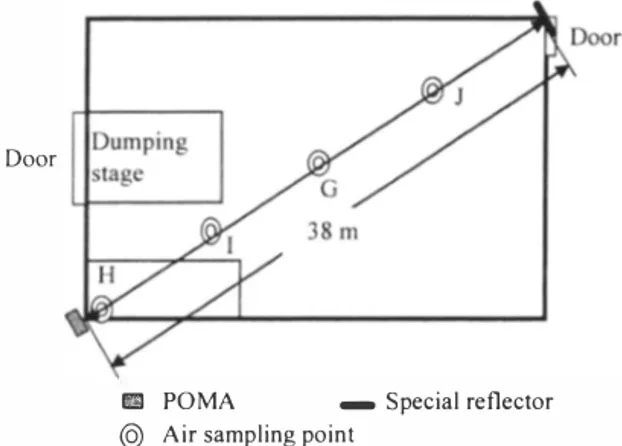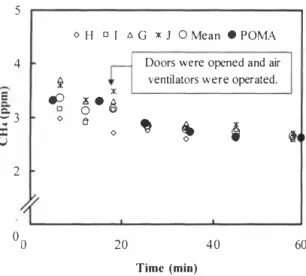Kalmar ECO-TECH '05 and
The Second Baltic Symposium on Environmental Chemistry KALMAR, SWEDEN, November 28-30, 2005
A PRACTICAL APPLICATION FOR
MONITORING METHANE IN AMBIENT AIR AT
WASTE DISPOSAL FACILLITIES USING A
PORTABLE OPEN PATH ANALYZER
Noboru Tanikawa
Toru Furuichi
Kazuei Ishii
Kohji Matsuo
Hokkaido University, Japan
ABSTRACTIt is well known that methane (CH4) is a greenhouse gas, and one of the main gases emitted from landfills, CH4 is also emitted from biogasification facilities and composting facilities, A new method to monitor CH4 in ambient air has been developed using a portable open path methane analyzer (POMA) that is retailed as an urban gas leak detector. In this study, we have investigated a practical application of a POMA in the field, and the characteristics of CH4 emissions at landfill sites, biogasification facilities, and a composting facility,
It is clear that this new method is convenient, and can be used to monitor the average concentration of CH4 in ambient air at a waste disposal facility, such as a landfill site, a composting facility, or a biogasification facility, The concentration of CH4 in ambient air at landfill sites, a composting facility, and biogasification facilities were found to be 2-30, 2-13, and 3-13 ppm, respectively,
KEYWORDS
Methane; Open path type analyzer; Landfill site; Biogasification; Composting 1 INTRODUCTION
Methane (CH4) is known to be a major greenhouse gas emitted from landfill sites, It is necessary to measure the volume of methane emitted from landfill sites to judge the stability of a landfill site, and to examine its contribution to global warming, However, it is very difficult to measure the total representative volume of landfill gas from a landfill site, because various landfill gases are heterogeneously emitted from gas venting tubes, and also from the surface of the landfill site, It is also well known that CH4 is heterogeneously emitted from waste treatment facilities, such as composting facilities and biogasification facilities,
To obtain a representative emission of C� from a landfill site and a waste treatment facility (waste disposal facility), it is necessary to obtain many samples from the gas venting tubes and the ambient air at the landfill site and waste disposal facility, and then analyze the collected
Kalmar ECO-TECH '05 and
The Second Baltic Symposium on Environmental Chemist!) KALMAR, SWEDEN, November 28-30, 2005
samples. This is very laborious, time consuming, and costly, and there are hopes that a new and simple method for monitoring CH4 in ambient air can be developed to provide the desired information in a cost-effective manner.
We have investigated the use of a portable open path-type analyzer for monitoring representative values of CH4 at waste disposal sites that is quicker and easier to use than conventional analyzers [ l, 2]. We reported on a method for using these portable open path-type methane analyzers that was convenient and usable for monitoring the average concentration of CH4 in ambient air at a landfill site [1]. In this study, we have investigated a practical application for monitoring CH4 in ambient air at a waste disposal facility using a portable open path-type methane analyzer, and have examined the characteristics of CH4.
2 MATERJALS AND METHODS
2.1 Instrument and its principle of operation
Figure 1 shows a photograph of a portable open path methane analyzer (POMA) that is retailed as an urban gas leak detector. The POMA consists of an electronics unit, an optics unit, and a connecting tube. It has an InGaAsP distributed-feedback laser light source in the electronics unit. The wavelength of the laser is stabilized at an absorption line of methane (the 1,640-1, 700 nm band of the R(3) line (A= 1.65372 µm)) that is
free from interference from atmospheric gases. The laser light is coupled to a single-mode optical fiber in the connecting tube and guided to the optics unit. Table 1 shows the specifications and performance of the POMA.
A schematic method for monitoring the concentration of CH4 using the POMA is shown in Figure 2. The optics unit transmits the laser
beam to the special reflector, and part of the Figure 1. The portable open path
backscattered light is condensed onto a methane analyzer used
photodetector. The photodetector output is fed
Table 1. The specifications and performance of the the portable open path type methane analyzer
Wavelength-modulation
Detection principle spectroscopy for infrared absorption Light source lnGaAsP distributed-feedback laser
Wavelength (nm) 1653.7
Response time (s) 0.1
Detection distance (m) <30
Lower detection limit (ppm•m) 50
Upper detection limit (ppm•m) 6000 4.4 in total
Weight (kg) (Electronics unit : 3.2, Optics unit: 0.9, Connecting tube: 0.3)
Dimensions (mm) Electronics unit : W 195, D 260, H88 Optics unit: W 114, D 244, H206 Battery Nickel-metal hydrate battery( 12 V)
. urat1on o ' . Th 1 55 55 surface at opposite ends of the Populatwn ie
"' s;._ _______________ _ an dfill site, spaced about 38 m ..;.c..;. o_m;..;. m..;. u;;.. n...;. n_
l
Kalmar ECO-TECH '05 and
The Second Baltic Symposium on Environmental Chemist!)
KALMAR, SWEDEN, November 28-30, 2005
into the electronics unit, an d this is converted into the absorption factor of the laser light. The
POMA measures the path-integrated methane concentration (in units of ppm·m) between the optical unit and the special reflector. The concentration of CH4 is calculated using Equation 1
CH4 (in ppm)= MIX (I)
where M = the path-integrated methane
concentration (in units of ppm·m) and X = the X (m)
Optics unit distance (in m).
2.2 Method
The concentration of CH4 in ambient air
measured by varying the distance between the Special
POMA and the special reflector, at two landfill reflector
sites (Landfill sites A and 8) is shown in Table 2, at three kitchen waste biogasification facilities (Facilities C, D, and E) in Table 3, and at a
composting facility (Facility F) in Table 4. Figure 2. A schematic drawing of the method/or monitoring the
Landfill site A was a controllable closed system concentration of CH4 using disposal facility (CSDF), which is increasingly the POMA
being used in Japan. A CSDF has a barrier, such
as a roof or an artificial Table 2. Outline of landfill site tested foundation that can prevent
Electronics unit
.
LandfillI site·o A LandfillI site· B
. . .
rainfall from mfiltratmg . O reclamation the cond1t10ns e phystca f 2002- 1979-waste.
( e.g., temperature an d water Reclamation area (m2) content) within the waste layers
can be controlled, depending on the quality of the landfilled waste,
1000 101,500
Pulverized
incombustible waste Domestic waste and plastics, Ash
Landfilled without imposing any impact on solid waste the environment. Landfilled
waste is pulverized
Table 3. Outline of kitchen waste biogasification
incombustible waste, plastics, tJ:cilities tested
an d ash. It is estimated that these
Facili� C Facili�D Facili� E have a low content of easily
Fennentation biodegradable organic matter.
The POMA and the special ternperature ( 0C) 35 55
16
Treatment capacity of reflector were positioned at a kitchen waste
.Lm
22height of 7 m above the lan dfill . .
m 41,000 94,000 42,000
apart, and the concentration of CH4 between them was periodically measured. For comparison, the air at the midpoint between the optical unit an d the special reflector (Point G)
was sampled using a plastic tube, and the sample gas was introduced into the continuous CH4 analyzer. Its specifications are shown in
Table 5. The air at Point H, Point I, and Point J,
Table 4. Outline of composting facility (Facilitv F)
Raw Livestock excreta, kitchen waste, material and r.ulverized wood waste
Treatment 26 (t/d)
capacity
Kalmar ECO-TECH '05 and
The Second Baltic Symposium on Environmental Chemistry KALMAR, SWEDEN, November 28-30, 2005 shown in Figure 3, was
intermittently sampled into plastic bags through a plastic tube and the concentration of CH4 was measured using the
continuous CH4 analyzer. Door
Landfill site B was divided into four sections. Domestic waste, including kitchen garbage, was sent to direct landfill. It is estimated that much organic matter was present at Landfill site B, The concentration of CH4 was measured in each section at a height of about 1.5 m using the POMA.
The main equipments were located in rooms at the Table 5, The specifications of the
conventional CH 4 analyzer
kitchen waste biogasification facilities, The
concentration of C� in ambient air in the main Measurement Range Sample flow rooms, where CH4 might leak, was measured, The principle (ppm) (ml/min) concentration of C� in ambient air at a Flame ionization
fl.l!I POMA - Special reflector @ Air sampling point
Figure. 3 An outline of the monitoring of the concentration of CH 4 at Landfill site
composting facility was also measured.
3 RES UL TS AND DISCUSSION
3.1 Landfill sites
At Landfill site A, the 5
concentration of CH4 varied over the range 2-4 ppm, This is higher 4 than the level in the outside air, because it contains a contribution from the landfill gas, Examples of the change in CH4 concentration measured by the POMA and the continuous CH4 analyzer at Point G are shown in Figure 4, When essential works (for example, dumping or bulldozing of the waste) is carried out at Landfill site A. the door of the landfill site 0 is opened, and the air ventilators 0 are operated, As illustrated in
Figure 4. measurements were
0- IO 900
detector method
- FID (point G) • POMA
Doors were opened and air ventilators were
operated,
20 40
Time (min)
recorded for a period of 18 min, Figure 4. An ex ample oft he change in concentration and then the door was opened,
of CH 4 at Landfill site A and the air charging system was
Kalmar ECO-TECI I '05 and
The Second Baltic Symposium on Env ironmental Chemistry KALMAR, SWEDEN , November 28-30, 2005
operated. During the initial 18 min, the concentration of CH4 measured by the POMA was
approximately equal to that measured by the continuous CH4 analyzer. After 18 min, the
concentration of CH4 measured by the POMA and the continuous CH4 analyzer decreased
gradually as the outside air entered and diluted the methane-rich air inside. The concentration of CH4 measured by the POMA was also approximately equal to that measured by the continuous
CH4 analyzer.
An example of the change in CH4 concentration measured by the POMA and that at Points G, H, I, J using the continuous CH4 analyzer is shown in Figure 5. During the initial I8 min, there were differences in the concentration of CH4 at Points G, H, 1, J, and the mean CH4 concentration at Points G, H, I, J were approximately equal to those measured by the POMA. After 18 min, the outside air entered and mixed with the inside air. After this had occurred, there was little difference between the CH4 concentration at Points G, H, I, J, and that from the POMA. Namely, it was clear that the POMA can monitor representative values of CH4 concentration in the landfill site where CH4 is heterogeneously emitted.
The results ofCH4 in ambient air at Landfill site B are shown in 5
Table 6. Domestic waste,
including kitchen waste, is sent o H □ 1 6 G :i: J O Mean • POMA
to landfill at Sections 3 and 4. It
seems that large volumes of 4 Doors were opened and air landfill gas are emitted at
i
ventilators were operated.'
�
'
Sections 3 and 4, as the organic :i:
9J
8 · �
matter contained in the waste is� 3 t)
active!) degrading. More than ◊
::c
◊20 years have passed since
u
t
Section I was completed, and more than I O years have passed 2 since Section 2 was completed. The peak activity of the organic degradation in each section is
considered to have passed, and 00 20 40
60
the volume of landfill gas
produced has reduced. The Time (min)
concentration of CH4 in ambient
Figure 5. Another example of the change
air at Sections 3 and 4 was
higher than at Sections I and 2. in concentration of CH 4 at The maximum reading observed Landfill site A
was 30 ppm. The concentration
of CH 4 in ambient air at Sections I and 2 Table 6. CH
4 in ambiem air
sometimes increased when the wind blew in from al Landfill sile A Sections 3 and 4.
Duration of CH4
3.2 Biogasification facilities and composting reclamation (ppm)
facility Section I 1979 - 1983 3.3 - 6.0
Section 2 I 984 - I 992 1.8 - 5.2 CH4 in ambient air in the main rooms of the kitchen Section 3 1993 - 1.8 - 9.6 waste biogasification facilities could be Sect10n 4 1999 - 2.9 - 30.0 conveniently and quickly measured by the POMA.
and ventilation), and the Methane fermentation
therefore, negligible. Test Waste water treatment
Kalmar ECO-TECII ·05 and
The Second Baltic Symposium on Environmental Chemistry KALMAR, SWEDEN, November 28-30, 2005 The results are shown in Table 7. CH
4 in ambient air at kitchen waste
Table 7. This data changed. biogasification facilities depending on the conditions
CH4 (ppm)
of the room (e.g., type of Room
Facility C Facility D Facility E operation. volume, sealing,
2.8 - 3.7 2.0 - 2.8 3.5 - 12.8 values were small and
equipment is available m �r=o=o =�---4.9 - 5.1 2.0 - 2.7 1.9 - 2.0 m roo to -=o__Elect,,, ---:- ---ric generator
detect accidental CH4 leaks, 5.2 - 7.5 1.9 - 2.0
m
which can measure the �r�0�0 =�--,---Solid residual
concentration of CH4 at the 2.1 - 2.4 3.1 - 11.4
percent level. The POMA is ..,tr ..., e"'a""t=em-"'n._t ._.ro..,o.am.:.:-_______________ _
more useful for a rapid early
detection of accidental CH4 leaks, as it can monitor the Table 8. CH 4 in ambient air at concentration of CH4 at the ppm level. the composting facility
Height (m) I 2 3
The results measured by the POMA in the central region CH. (ppom) 4.6 7.2 1 2.8 of the composting facility are shown in Table 8. The ---
concentration of CH4 depended on the measurement height. The concentration of CH4 at a
height of I m was lower than that at a height o f 3 m. It is presumed that the gases that are
emitted by the degradation of organic matter, which includes CH4, rise, and are diluted as their
temperature increases. The concentration of CH4 at a height of 1 m varied with changes in
location. and was in the range 3-6 ppm. This was because of the active degradation area in the
composting equipment was limited.
4 CONCLUSIONS
We have developed a practical application for monitoring CH4 in ambient air at waste
disposal facilities using a portable open path-type methane analyzer, and have used it to
investigate and characterize the concentration of CH4 in am bient air. The following
conclusions were reached:
A POMA can conveniently and quickly monitor the concentration of CH4 in ambient air at
landfill sites, kitchen waste biogasification facilities, and composting facilities, where CH4 may be emitted heterogeneously.
The concentration of CH4 varied over the range, 2-4 ppm at the landfill sites where
pulverized incombustible waste, plastics, and ash were landfilled.
The concentration of CH• varied over the range, 2-30 ppm at the landfill sites where
domestic waste, including kitchen garbage, was directly landfilled.
The concentration of CH4 varied over the range, 2-13 ppm at the kitchen waste biogasification facilities.
The concentration of CH4 varied over the range, 3-13 ppm at the composting facility. ACKNOWLEDGEMENT
Kalmar ECO-TECH '05 and
The Second Baltic Symposium on Environmental Chemistry KALMAR, SWEDEN, November 28-30, 2005
REFERENCES
[ I ) Tanikawa N,, Furuichi T., Ishii K., and Matsuo K., 2004. Development of convenient monitoring method of methane in ambient air at landfill sites using portable open path type analyzer. In: Proceedings of the 3rd Asian Pacific Landfill Symposium, Kitakyushu, Japan, pp, 411-416.
[2) Tanikawa N., Furuichi T., and Ishii K., 2003. Monitoring of methane and carbon dioxide in ambient air at landfill sites, In: Proceedings of the 9th International Waste Management and Landfill Symposium, Sardinia 2003. Sardinia, Italy.



